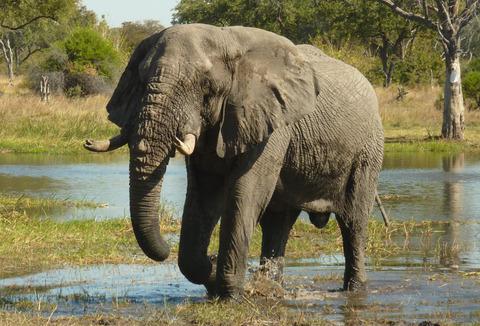当前位置:
X-MOL 学术
›
Funct. Ecol.
›
论文详情
Our official English website, www.x-mol.net, welcomes your
feedback! (Note: you will need to create a separate account there.)
Improved estimation of gut passage time considerably affects trait‐based dispersal models
Functional Ecology ( IF 4.6 ) Pub Date : 2020-12-04 , DOI: 10.1111/1365-2435.13726 Andrew J. Abraham 1, 2 , Tomos O. Prys‐Jones 1 , Annelies De Cuyper 3 , Chase Ridenour 1 , Gareth P. Hempson 4 , Toby Hocking 1 , Marcus Clauss 5 , Christopher E. Doughty 1
中文翻译:

改进的肠道通过时间估计会大大影响基于特征的扩散模型
更新日期:2020-12-04
Functional Ecology ( IF 4.6 ) Pub Date : 2020-12-04 , DOI: 10.1111/1365-2435.13726 Andrew J. Abraham 1, 2 , Tomos O. Prys‐Jones 1 , Annelies De Cuyper 3 , Chase Ridenour 1 , Gareth P. Hempson 4 , Toby Hocking 1 , Marcus Clauss 5 , Christopher E. Doughty 1
Affiliation

|
- Animals are important vectors for transporting seeds, nutrients and microbes across landscapes. However, models that quantify the magnitude of these ecosystem services across a broad range of taxa often rely on generalised mass‐based scaling parameters for gut passage time. This relationship is weak and fundamentally breaks down when considering individual species, indicating that current models may incorrectly attribute or estimate the magnitude of dispersal.
- We collated a large dataset of gut passage time for endothermic animals measured using undigested markers (n = 391 species). For each species, we compiled trait data, including body mass, morphology, gut physiology, diet and phylogeny. We then compared the ability of five statistical models (constant, generalised least squares, phylogenetic generalised least squares, general linear model and random forest) to estimate the time of first marker appearance (transit time; TT) and mean marker retention time (MRT) for particle and solute markers in mammals and birds separately.
- For mammals, we found that the inclusion of additional traits appreciably reduced the median root‐mean squared error across all markers in a leave‐one‐out cross validation. For birds, however, additional traits did not significantly improve our ability to predict gut passage time across markers. This may have occurred due to the smaller number of bird species included in our analysis or the absence of important explanatory factors such as differences in gastrointestinal morphology.
- Using the MRTparticle random forest model from this study, we updated two trait‐based dispersal models for seed and nutrient movement by mammals. The magnitude of dispersal in our updated predictions ranged from 66% to 176% of the original model formulation for different scenarios, highlighting the importance of gut passage time for dispersal models. Furthermore, the contribution by individual or groups of species was found sizeably altered in our updated models.
- Future modelling studies of dispersal by mammals, for which empirical estimates of gut passage time are absent, will benefit from predicting gut passage time using statistical models that incorporate traits including animal morphology, diet and gut physiology.
中文翻译:

改进的肠道通过时间估计会大大影响基于特征的扩散模型
- 动物是在景观中运输种子,营养和微生物的重要载体。但是,用于量化这些生态系统服务范围广泛的分类单元的模型通常依赖于基于一般质量的缩放参数来评估肠道通过时间。当考虑单个物种时,这种关系是微弱的,并且从根本上打破了这种关系,这表明当前的模型可能错误地归因于或估计了扩散的幅度。
- 我们整理了使用未消化的标记物(n = 391种)测得的吸热动物肠道通过时间的大型数据集。对于每个物种,我们收集了特征数据,包括体重,形态,肠道生理,饮食和系统发育。然后,我们比较了五个统计模型(常数,广义最小二乘法,系统发育广义最小二乘法,一般线性模型和随机森林)估计第一次标记出现时间(运输时间; TT)和平均标记保留时间(MRT)的能力。分别用于哺乳动物和鸟类的颗粒和溶质标记。
- 对于哺乳动物,我们发现,在留一法交叉验证中,包括其他特征在内的所有标记均显着降低了所有标记的中值均方根误差。但是,对于鸟类来说,其他特征并不能显着提高我们预测肠道跨标记时间的能力。这可能是由于我们的分析中所包含的鸟类种类较少或没有重要的解释性因素(例如胃肠道形态的差异)而发生的。
- 使用来自这项研究的MRT粒子随机森林模型,我们更新了两个基于特征的散布模型,用于哺乳动物的种子和养分运动。在不同情况下,我们更新的预测中散布量的范围从原始模型公式的66%到176%不等,突显了肠道通过时间对于散布模型的重要性。此外,在我们更新的模型中,个体或群体的贡献被大大地改变了。
- 缺乏对肠道传播时间的经验估计的哺乳动物扩散的未来模型研究,将受益于使用结合了动物形态,饮食和肠道生理等特征的统计模型来预测肠道传播时间。











































 京公网安备 11010802027423号
京公网安备 11010802027423号